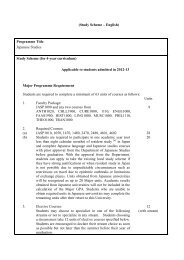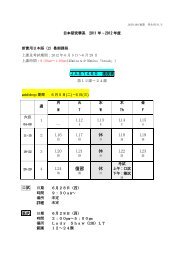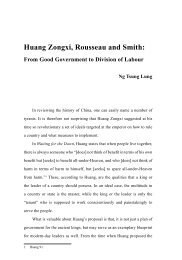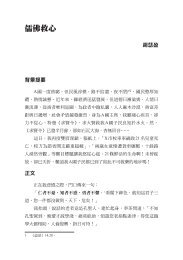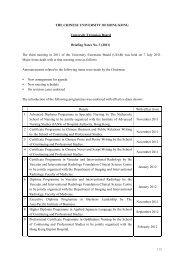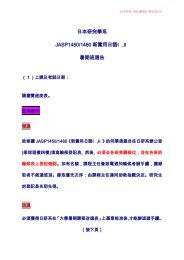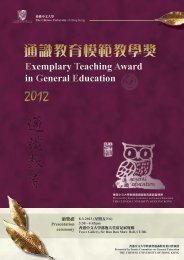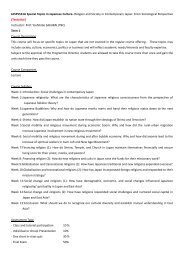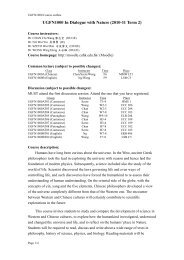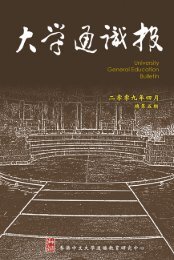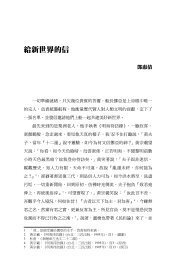Article
Article
Article
Create successful ePaper yourself
Turn your PDF publications into a flip-book with our unique Google optimized e-Paper software.
Internationalization of BUDO CultureIMPORTANT QUESTIONSFOR THE FUTURE OF BUDOBy Stephen Robert Nagy“HENCEFORTH, FOREIGNERS AS WELL WILL GAZE UPON THE MOON OF OUR JAPAN.”I. IntroductionThis statement was written in the early Meiji period byMuragaki Norimasa, a member of the first Japaneseembassy to the United States, and it reveals much aboutthe Meiji view of Japan and the discomfort Japanese hadat the time with sharing their world with Westernersand other non-Japanese. This discomfort still lingersin most areas of contemporary Japanese society whenone surveys the mass media portrayals of foreigners,recalcitrant immigration policies vis-a-vis foreigners,and within the context of this magazine, the world ofmartial arts.Not withstanding this continued discomfort, accordingto Tanaka Mamoru Sensei of the International BudoUniversity, budo continues to grow in popularity outsideJapan with the total number of budo practitionersestimated at 5,000,0001. This number includes1,000,000 judo practitioners, 3,000,000 karateka andthe remaining 1,000,000 practising other budo suchas kendo, iaido etc. In fact the total number of budopractitioners abroad parallels the number of totalpractitioners in Japan.(MEXT), in conjunction with Nippon BudokanFoundation and the Japanese Budo Association held the19 th International Seminar for Budo Culture (commonlyreferred to as the “Budo Seminar”) at the InternationalBudo University located on the north eastern shore ofChiba Prefecture. Participants were able to experienceup to three modern budo (from aikido, karate, kendo,kyudo, judo, jukendo, naginata, shorenji kempo andsumo). Moreover, budo enthusiasts also experienced aclassical budo (Negishi-ryū, a classical martial art thatspecialized in shuriken (throwing objects), trained intheir own main style, and attended lectures on budoculture, history, philosophy, and shared their thoughtson the “Future of Budo” in both an open forum andshort essay.The International Budo UniversityAs in previous years, in March 2007, the Ministry ofEducation, Culture, Sport, Science and TechnologyIn an era in which less and less Japanese are practisingbudo, the “Future of Budo” is an extremely pertinent2
question for budo practitioners (Japanese andnon-Japanese alike). So much so that the memberorganizations of the Japanese Budo Association cametogether in April 1987 to put forth the “Budo Charter”,which highlights that the very essence of budo isunder threat as, “a trend towards infatuation just withtechnical ability compounded by an excessive concernwith winning.”2Above and beyond this negative trend identified by theJapanese Budo Association, the attendees of the 2007seminar also identifi ed numerous other importantquestions concerning the “Future of Budo” including;What does the Japan Association for the Promotion ofBudo mean when it speaks of the internationalizationof budo culture and the future of budo? Is theinternationalization of budo coeval with the promotionof budo abroad as a representative of Japanese culture?Do they mean spreading budo culture to countries interms of popularity? Does the dissemination of budoculture to countries around the world include budobecoming indigenized, with budo being taught by localswho are budo authorities in their respective categoriesbut also in Japan? When does budo cease being thecultural property of the nation of Japan and becomethe cultural property of the practitioner?Reflecting on these questions and prompted by mynearly decade long experience with budo in Japan,my attendance at three International Budo CultureSeminars, in addition to my own doctoral dissertationthat delves into the meaning of internationalizationwithin Japan in contemporary society, I then wonderedto myself who owns the rights to teach and representJapanese budo, whether it be kendo, iaido, aikido, judoor any other the other martial arts that fall under therubric of budo, and how will this impact the “Futureof Budo?”From this perspective this short essay aims to considerthe internationalization of budo culture and theimplications of the above “discomfort” by posing seriousquestions that the leaders of the budo world must askthemselves if budo is destined to become successfullyinternationalized. The discussion will take place inthree sections. The first will introduce the non-Japanesepioneers of budo. The purpose of this investigation istwofold; first, to provide real examples of those budopractitioners that have been instrumental in openingthe doors of the Japanese budo world to the latergenerations of international budo practitioners. Secondand significantly, this section illustrates that budo isno longer the strict purvey of Japanese nationals. Thesecond section then discusses the present day situationof budo in Japan with the intention of emphasizingthat internationalization of budo is currently hamperedby the fact that accomplished budo practitioners fromaround the world are still not recognized by theirpeers in Japan. The third discusses the future of budo,providing suggestions as to how to secure a bright andvibrant future for budo within Japan and abroad.II. Early Budo Pioneers from around the WorldSince the end of WWII, the ranks of budo practitionersfrom other countries have grown unabated. Impressively,some individuals like the late Donn Draeger haveattained the highest ranks available in classical stylessuch as Tenshin Shōden Katori Shintō-ryū3, while otherssuch as Gordon Warner4, Don Trent5 (kendo Kyōshi7-dan, iaido Renshi 7-dan) and Aikikai’s ChristianTissier6 have performed similar admirable feats in themodern budo, opening the doors for younger budopractitioners from around the world to practice andenjoy budo. Without their pioneering efforts, onewonders if the world of Japanese budo would be as opento practitioners from around the world as it is today.These individuals forged the road for the second andthird generation of non-Japanese budo practitioners bynot only becoming accomplished budo practitionersovercoming adversity, but also acting as windows intoJapan and the budo world. Some acted as translators andinterpreters, served as the Japanese contact, introducedinterested individuals to teachers, provided equipmentand in many cases acted as surrogate teacher for studentsof budo. In the author’s case, the aforementionedTrent Sensei was gracious enough to introduce him toa kendo dōjō, teach kendo basics, provide equipmentand crucially, acted as an interpreter for both kendoand iaido when the author’s language skills were stillrudimentary. His stories, teaching and valuable timecomplemented and accelerated the budo learningprocess while also exposing the author to all levelsof budo through competitions, gruelling afternoonpractices and the odd night in a Japanese pub.Entering the autumn of life, Trent Sensei along withhis equally accomplished wife continues to supportenthusiastic budo practitioners from around the world,facilitating their exposure to budo both in terms ofquality and importantly, authentic main line budo(kendo and iaido).The shugyō (austere training) of the early foreigner budopioneers including Gordon Warner’s infamous earlyShōwa period zenkoku musha-shugyō (country-widepractice or austere training), and Aikikai’s ChristianTissier amongst others, who endured an environmentmuch less inviting than international budo practitionersKendo World 3.4 2007 3
face today. What is astonishing about these individualsis that they somehow managed to persevere throughbullying tactics, cultural differences, discriminationand perception that fall under the umbrella of theNihonjinron (Theory of Japanese) that assumes that onlyJapanese can embody Japanese arts and philosophiesbecause of their unique cultural climate.At the time, these obstacles were merely part of theirpaying their dues. However, upon refl ection; thesechallenges were the anti-thesis of the essence of budo,creating unpalatable, competitive behaviour instead ofbehaviour that included cooperating with each otherto improve technically and attain the ideals of budo.In essence, exactly the kind of budo practitioner theJapanese Budo Association is against cultivating.Importantly, these experienced budo practitioners’link prewar budo and post-war budo, conveying to thenewest generations of budo practitioners the enormouschanges that have occurred vis-a-vis the practice ofbudo. Again, looking back at first hand encounterswith Trent Sensei, the author was fortunate to hear aplethora of fascinating, first hand stories from TrentSensei concerning degeiko (the visiting of different dōjōto practice), the amazing life story of Nakakura KiyoshiSensei (kendo Hanshi 9-dan, iaido Hanshi 9-dan) whomentored Trent Sensei in the ways of kendo and Japan,and true and tested ways to not fit “kendo into yourlife”, but “life into your kendo.”Challenges aside, these budo pioneers opened the doorsfor their juniors by demonstrating that non-Japaneseare not only interested in budo, but also capable ofpersevering through intensive training to become skilledand accomplished budo practitioners.II. Budo TodayNot withstanding the achievement of these budo leadersfrom around the world, there is still a deep and widegap preventing these accomplished and experiencedbudo practitioners from becoming representatives ofbudo in Japan. This reality is vividly illustrated when weexamine the representatives of budo at the InternationalBudo Seminar, lecturers on budo history, culture andphilosophy. Similarly, when one attends kendo or iaidotraining seminars, one often sees more accomplishedbudo practitioners from around the world being taughtby less accomplished colleagues from Japan. In theaforementioned cases, these bilingual, bi-cultural andthoroughly accomplished budo enthusiasts are allocatedto the role of interpreter and translator.Can non-Japanese be accepted as authoritative figures ofbudo culture or does nationality continue to be a hurdle?If so, what are the implications for the internationalizationof budo when non-Japanese are never really recognizedas authoritative representatives (academically or in termsof a fully fledged practitioner)?This dilemma has been recognized by certain elementsof the Japanese governmental bureaucracy. Namely, inMarch 2003, the Agency of Cultural Affairs publisheda report entitled “About the Future Promotion ofInternational Cultural Exchange” in which it explicitlystated that Japanese can no longer consider themselvesthe sole representatives of Japanese culture.7 Thisenlightened vision of purveyors of Japanese cultureincludes properly trained individuals from around theworld becoming representatives of Japanese cultureand traditions not only in the capacity of a localrepresentative when no Japanese national is available,rather as an authoritative figure that is charged with theresponsibility of teaching Japanese culture.MEXT has similarly, although half-heartedly sponsoredthe annual Budo Seminar for international budopractitioners with the purpose of cultivating not onlyaccomplished budo practitioners, but those with a broadset of budo experience in addition to being educated inthe history, philosophy and tradition of the developmentof budo. With 19 successful seminars being held andattendees returning year after year for additionalinstruction, it has achieved some success in realizingthis goal. In fact, some participants have become notonly accomplished high ranking budo practitionersbut also achieved success and recognition in the worldof the Tea Ceremony and in academia with a doctoraldissertation on “bushidō” and several publications bothin Japanese and English on various budo.Despite the numerous accomplished budo practitionersfrom around the world, it is interesting to note that theyare still not acknowledged for their accomplishmentsand expertise in becoming representatives of variousbudo at events like the Budo Seminar or at trainingseminars for budo practitioners at large in Japan.When we begin to ask questions about the future of budoin Japan and abroad we need to begin to ask ourselveswhat does the internationalization of budo mean? Doesinternationalization of budo imply that non-Japanesewill always be subordinate to Japanese? Will centresof budo outside Japan grown in importance, perhapssurpassing that of Japan? Can budo become trulyinternationalized when a hierarchy of budo practitionersexists, namely, based on nationality rather than skill,quantifiable knowledge and experience?4
IMPORTANT QUESTIONSFOR THE FUTURE OF BUDOIII. The Future of BudoThe internationalization of budo has gone through atleast two stages since the close of the Pacific War. Thefirst included the prodigious efforts by budo practitionersfrom around the world to become accomplishedtrainees of budo. The second stage, at least from theperspective of the author, is characterized by today’spresent stagnant situation; with accomplished andexperienced budo practitioners from around the worldreaching high levels of technical and philosophicalproficiency, paralleling their Japanese colleagues onall levels, save for perhaps Tokyo University levelmastery of the Japanese language. This second stageis also marked by the continued reticence to endowinternational budo practitioners with the same authorityand respect as their Japanese colleagues hamperingbudo’s internationalization.In the world of academia, authority is derived on a setof nearly global standards, the possession of a Ph.D.;Numerous peer reviewed publications in an individual’sfield of specialization and of course one’s level ofacademic activity which could include teaching andpresenting at international conferences. Nationality,ethnic background, religious affi liation or otherwiseplays little role in achieve success and being able torepresent your field of study. For example, many ofJapan’s so-called first tier universities such as TokyoUniversity, Kyoto University, Waseda University andKeio University employ scholars from around theworld. In the capacity of professors, they teach studentsabout a host of themes ranging from political science togender studies, the history of budo to the Meiji periodeconomic reform.In the world of sport, in particular baseball is illustrativeof the acknowledgement of ability and knowledgeinstead of nationality in terms of becoming a worldrenowned representative. Suzuki Ichirō, NomoHideo and Matsui Hideki have all become not onlyaccomplished baseball players in the Major Leaguesbut also representative figures, who of course representJapan but more importantly baseball at home andabroad.The author wonders openly if the world of Japanesebudo can learn from the example of the worlds ofacademia and sport, acknowledging technical expertise,experience and ability rather than nationality as requisitesfor authority and the positive impacts that recognitionwould have on the “Future of Budo”. Academia in Japanhas gained greatly from the infusion of fresh and novelperspectives on things “Japanese”. Similarly, baseballhas secured is future with the promotion of the sportaround the world but also recognizing players for theirexcellence rather than nationality as illustrated by itsworldwide popularity and “star players” from countriesaround the world.The member organizations of the Japanese BudoAssociation have attempted to broach this problemthrough the promulgating the Budo Charter.8 Theproblem with this charter is that it does not entirelyaddress the fundamental obstacles hampering theinternationalization of budo presented so far.Returning to the questions posed at the beginning of thisessay, the author believes that the “Internationalizationof Budo” and the “Future of Budo” are unquestionablylinked. For budo to have a future here in Japan andabroad the current leadership needs to (1) clearly identifythe relevance of contemporary budo both domesticallyKendo World 3.4 2007 5
IMPORTANT QUESTIONSFOR THE FUTURE OF BUDOand internationally; (2) separate budo as a Japanese wayand emphasize that the principles espoused by budo areuniversally important and applicable to daily life in allcountries and cultures; (3) expand the current leadershipto include representatives from around the world; (4)expand the current torch bearers of “authentic” budo toinclude accomplished and knowledgeable practitionersfrom around the world; (5) and remove Japaneselanguage perquisite from the Kyōshi, Hanshi rankingsystem (in the case of kendo).Clearly identifying the value and relevance of budopaves the road towards the inclusion of budo not justin clubs, local dōjō or an elective at schools, but to beintegrated into the education system in a more profoundand comprehensive manner. For example, budo can beapproached historically, religiously, philosophically,technically and from the vantage point of physicaleducation. The merit of this approach is that itdemonstrates that budo as a subject is multidimensionaland is not just an activity that can be engaged in thedōjō but also one of many lenses to view the world.Also, a very crucial part of identifying the value andrelevance of budo is to avoid the temptation of associatingbudo with the national obsession of linking the creationof world peace with mutual understanding. Of coursethese are admirable goals in themselves. However, aserious investigation into where budo exactly fits inordinary life and what it can do for practitioners on apersonal and physical level would greatly contribute tocementing a positive and expanding role for budo in thefuture. Furthermore, the author believes it is importantto remember that in the end, budo begins as a physicalendeavour and ends as a physical endeavour that hasbeen moulded and cultivated through perseverance,self-reflection and serious study. This learning processrequires training, self-reflection and implementing yourconclusions to improving your respective budo. In short,budo is about cultivating the self before anything else,a reflection of the infusion of Zen into martial arts bysamurai in the Edo period to bring meaning to theirtraining and status in Edo society.The Budo Charter’s <strong>Article</strong> One does pay heed tothis point in a superfi cial manner by stressing the“building of character, the enhancement of senseof judgment, and becoming disciplined individualscapable of making contributions to society at large.”Unfortunately, the charter still needs to expand uponthe process of this transformation not just the endgoal. For instance, budo training requires patience,perseverance and communication skills in order torealize the ideals associated with budo. Similarly, publicand private relations require the same skills in order tonavigate through the changes of interpersonal relations.Separating budo as a Japanese way and emphasizingthat the principles espoused by budo, are universallyimportant and applicable to daily life in all countriesand cultures. This shift in ethnocentric chauvinismmakes budo more attractive as a lifestyle choice than themore lofty and common declarations of creating worldpeace through budo. Furthermore, this separation willpromote the internationalization of budo and secure itsfuture when practitioners know that they can obtain thehighest ranks available, regardless of nationality.It is hard to image anyone wanting to commit to anactivity, whether it is language studies, pottery or budo if6
they cannot personalize that activity in a way that allowsthem to use it as they will. In this respect the world ofbudo is seriously compromised in that non-Japanese, atleast at the moment are still not able to become leadersof budo in general (although they may be the nationalrepresentative in their home country), helping shapebudo’s future in Japan and abroad. This limitationseriously compromises the internationalization of budowhen a segment of its accomplished and experiencedpractitioners cannot seriously and in a meaningful waycontribute to shaping the future of budo.<strong>Article</strong> Six of the Budo Charter addresses this pointhowever, as highlighted in Section II of this essay thatthe promotion of budo is hampered by not recognizingall accomplished budoka. People do promote theinternationalization of budo, but it is crucial that thecentral pillar of budo, that is Japanese budo associations,infuse in their practitioners that all practitioners arebudoka first and, for example Australian, French orGerman nationals second. This of course does notmean that we lose or cultural background or disavow ofnationality, rather through this mindset, practitionerscan promote budo as a budōka, not a budōka from aparticular country.Expanding the current leadership to includerepresentatives from various countries makes thebudo road more tangible to new practitioners. It alsoprovides a direct conduit of current budo thought,trends and expectations, whether that is kendo, iaido orsome other form of budo, to practitioners in countriesaround the world. Expanding leadership to includeaccomplished representatives around the world alsofacilitates the diffusion of budo into all parts of theworld through the exchange of a diversity of view onhow to internationalize budo.Each country has particular needs. For instance,Islamic countries may need to incorporate a new pieceof head gear for female iaido practitioners so they cantrain and compete alongside their male counter parts.In some countries, women have become interested intraditionally male budo like sumo. Subsequently, toencourage the participation of female sumo wrestlersin the conservative and traditional world of sumo,the mawashi (the traditional trunks worn by sumowrestlers) uniform has been exchanged for clothingthat is appropriate for women practitioners. Clearly,internationalization of budo requires flexibility anda diversity of view. Its leadership as a result needsto be diverse to be able to adapt to the needs ofinternationalizing budo.Another step in securing the future of budo (kendoin particular) is removing the language barrier thatcurrently exists in the Renshi, Kyōshi and Hanshisystem. On the one hand, it is understandable that thosewho would represent Japanese budo be comfortable inboth spoken and written Japanese. In fact, the authorwould wager that the majority of budo practitioners inJapan and abroad would be highly suspicious of a budoteacher who didn’t have some degree of spoken fluencyand writing/reading ability. On the other hand though,although linguistic ability is indicative or your abilityto communicate in Japanese, in does not necessarilyrepresent your knowledge set, especially in a foreignlanguage.At the moment, examinations for Kyōshi and Hanshiin the world of iaido and kendo can only be written inJapan, obstacles that eliminate throngs of accomplishedbudoka who are highly qualified candidates exceptfor their Japanese language ability. Allowing eligiblecandidates to write their examinations in their nativelanguage when possible can only benefit the budoworld since it expands the number of ranked budōkafrom various countries, and as a consequence increasethe overall “Budo Human Capacity”, that is a bodyof individuals from around the world who are wellversed in the practice and philosophy of budo. As aside consequence, by allowing eligible individuals towrite examinations in languages other than Japanese,a library of high quality and advanced writing on budoin non-Japanese languages can be produced. It alsocreates a more inclusive system that ensures that is notdependent on language ability.IV. Final WordsIn short, the Budo Charter does much to lay thefoundation for implementing the aforementionedrecommendations. It also contributes to makingheadway in terms of breaching the continued gapbetween Japanese and non-Japanese budoka. Perhapsthe next step in securing the future of budo not onlyincludes revising the current charter to specifi callyhighlight the processes involved in attaining the statedin <strong>Article</strong>s One to Six, but also looking to the pastexamples of Japanese ways for adopting to change.Case in point, the world of Japanese budo is notunfamiliar with adapting for the times in an effort tosecure its future. Kanō Jigorō amalgamated techniquesfrom various jūjutsu styles to create judo, a budo anda sport that is enjoyed by millions around the world.Practitioners communicate through the training andcompeting together; they learn about judo’s Japaneseroots and preserve the essence of Kanō’s teachingsthrough competition, training and promoting judo asKendo World 3.4 2007 7
IMPORTANT QUESTIONSFOR THE FUTURE OF BUDOa sport and a budo. Aikikai’s Ueshiba Morihei similarlyfused jūjutsu and his various other interests into aikido,another budo enjoyed and practiced my millions aroundthe world.Returning to Morigaki Norimasa’s earlier statement,the “Future of Budo” depends on Japanese and non-Japanese budo practitioners gazing upon the moontogether. Only by working together as practitionersof budo can we secure a future for budo in Japan andabroad.End Notes Nippon Budokan Foundation. 2007. The 19th InternationalSeminar of Budo Culture Program. Japan. pp. 28-29. To access the Budo Charter in English or Japanese, please see theNippon Budokan homepage.http://www.nipponbudokan.or.jp/shinkou/html_1/maineng.html (Accessed March 27, 2007) For information in English on Tenshin Shōden Katori Shintō-ryūsee Reid, Howard and Michael Croucher. The Way of the Warrior:The Paradox of the Martial Arts, The Overlook Press, 1983. pp.118-151. For information in Japanese see Yokose Tomoyuki.Nihon no Kobudō, Nippon Budokan, 2000. pp. 11-24. Gordon Warner was born in 1916 in Long Beach California. Hebefriended Akio Maso who was born in a farming communityoutside of Tokyo. Akio was adopted by the daimyō of theMori clan, and named Mori Torao. He was trained as a kenshiand samurai by his wealthy father. Mori Torao met GordonWarner in 1934 at the University of Southern California inLos Angeles. Warner was attending on a swimming scholarshipand Mori was there to study English and Economics.The summer of 1938 saw the two good friends head for Japan tostudy kendo at Mori Sensei’s Uncle Junzō’s dōjō. By 1939, Warnerhad earned his shodan rank in kendo and iai. He also made somelife-long friends in Mori’s relatives, and was adopted by SasamoriJunzō as a son, as Sasamori only had two daughters. He left Japanwearing the mon of the Sasamori family on his dō. World War IIinterrupted Gordon Warner’s kendo studies, and he fought as aMarine Officer in the Pacific, while Mori Torao would go on tofight in the Kwantung Army in China as a Japanese Officer.See the following website for more information on Gordon Warnerhttp://www.e-budo.com/forum/showthread.php?t=33925(Accessed March 15, 2006) See Kendo World Volume 2.2 for a complete interview on TrentSensei. Also see Trent sensei’s Tsubomi Shinseikan homepage formore information on his location and iaido group. http://www.whi.m-net.ne.jp/~trent/index.htm (Accessed March 1, 2007) As of 2007, Christian Tissier was ranked 7-dan in Aikikai aikido.According to the Aikido Journal encyclopedia, Tissier Senseitrained for seven years in Japan.See http://www.aikidojournal.com/encylcopedia.php?entryID=698notion that the Japanese are the only bearers of Japanese culture.We should assume a posture that culture incubated in Japan isthe shared property perty of people in the wider world. This goes forthe tea ceremony, flower arranging and other everyday elementsof Japanese culture as well as for judo, karate, aikido and othermartial arts, all of which enjoy a large number of admirers andpractitioners throughout the world. With such fields as Japan’straditional performing arts, including Noh, kyōgen and Kabuki,or its traditional music, including koto and shamisen, there arenot only foreigners who admire and understand them, but alsomany who research them as well. Many people come to Japan tolearn these arts, and not a few Japanese go abroad to teach them.It will be necessary to create an environment in which all peoplewho cross Japan’s borders to participate in cultural activities areconsidered to be the bearers of Japanese culture irrespective oftheir nationality”. See pages 9-10 for a more complete discussionon way foreigners should and are needed to promote Japaneseculture abroad.http://www.mext.go.jp/english/bunka/03032401.pdf (Originallyaccessed March, 2005) See below for the 6 <strong>Article</strong>s which make up the Budo Charterhttp://www.nipponbudokan.or.jp/shinkou/html_1/maineng.html (Accessed March 27, 2007)ARTICLE 1: OBJECTIVE OF BUDO Through physical and mental training in the Japanesemartial ways, budo exponents seek to build their character,enhance their sense of judgement, and become disciplinedindividuals capable of making contributions to society at large.ARTICLE 2: KEIKO (Training) When training in budo, practitioners must always act with respectand courtesy, adhere to the prescribed fundamentals of the art,and resist the temptation to pursue mere technical skill rather thanstrive towards the perfect unity of mind, body, and technique.ARTICLE 3: SHIAI (Competition) Whether competing in a match or doing set forms (kata),exponents must externalize the spirit underlying budo. Theymust do their best at all times, winning with modesty, acceptingdefeat gracefully, and constantly exhibiting self-control.ARTICLE 4: DOJO (Training Hall) The dojo is a special place for training the mind and body.In the dojo, budo practitioners must maintain discipline,and show proper courtesies and respect. The dojoshould be a quiet, clean, safe, and solemn environment.ARTICLE 5: TEACHING Teachers of Budo should always encourage others to also strive tobetter themselves and diligently train their minds and bodies, whilecontinuing to further their understanding of the technical principlesof Budo. Teachers should not allow focus to be put on winningor losing in competition, or on technical ability alone. Above all,teachers have a responsibility to set an example as role models.ARTICLE 6: PROMOTING BUDO Persons promoting Budo must maintain an open-minded andinternational perspective as they uphold traditional values. Theyshould make efforts to contribute to research and teaching, anddo their utmost to advance Budo in every way. The full quote found in the report: “There is a need to rethink the8



